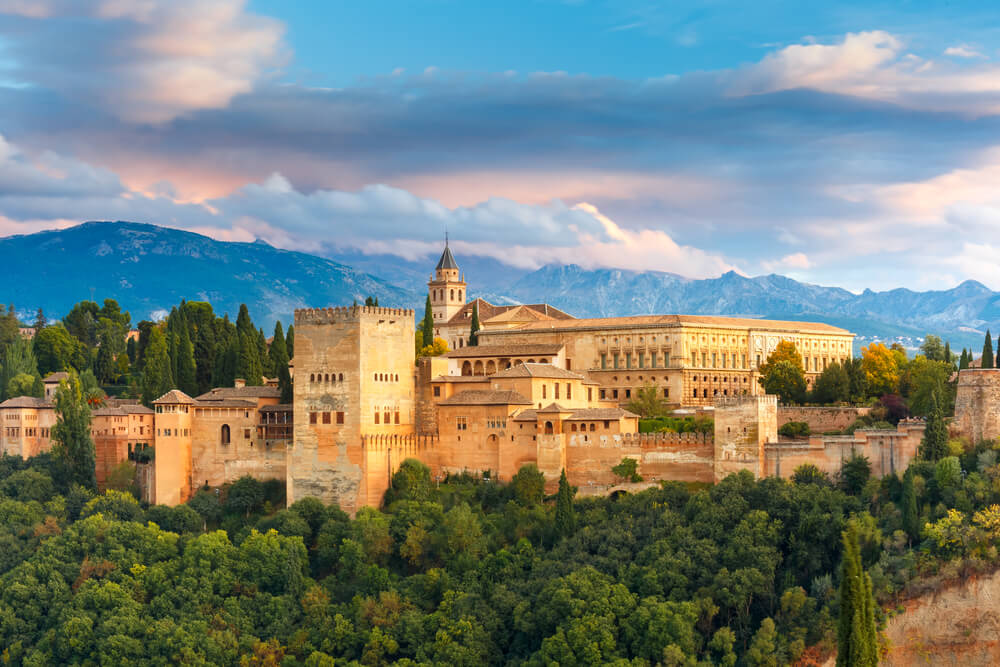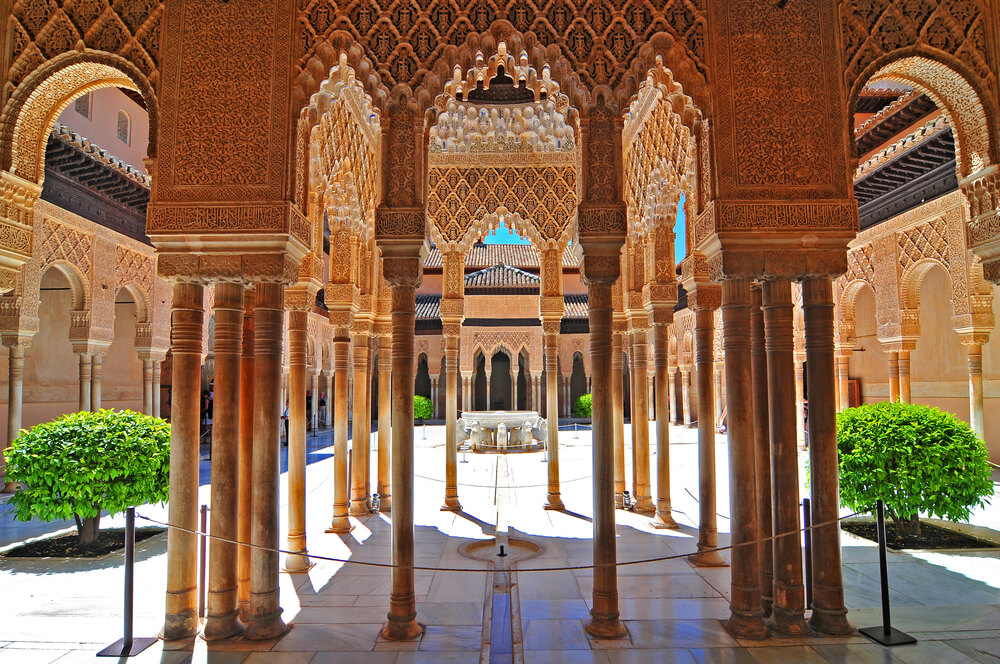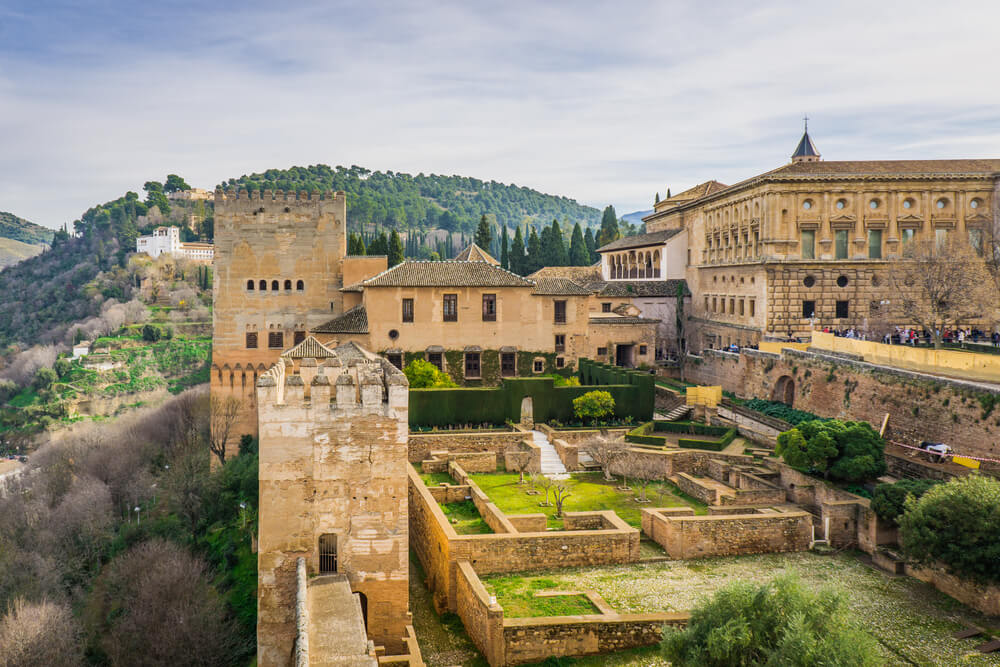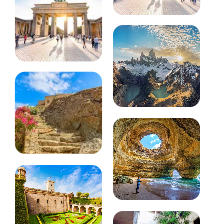Discover the Alhambra in Granada: a jewel of Spanish heritage

What is the Alhambra?
Perched on its hill, this veritable fortress is a sign of the great power once wielded by the Nasrids, the Muslim people who dominated Al-Andalus. Here’s a look back at the importance of this place steeped in history.
First of all, the Iberian Peninsula, in other words what is now Spain and Portugal, was under Muslim rule for a long time, between 711 and 1492 to be precise. Various dynasties succeeded one another, notably the Umayyads, the Almoravids, the Almohads and the Nasrids. It was the Nasrids who turned this small fortress, first built in the 9th century, into a unique, richly decorated landmark and symbol of an entire territory.
In the 13th century, the few structures that had been built on the hill were transformed into a succession of palaces and fortresses with the impressive architecture typical of the Nasrids. Some monuments from this period are no longer visible today, as they were destroyed or altered after Granada was reconquered by the Christians, but the Alhambra is the finest example still standing in the country.
It consists of a fortified enclosure housing the Alcazaba, the Nasrid palaces, the Generalife, the gardens and the palace of Charles V. Monuments and gardens covering more than 100,000 m²! The name of the Alhambra comes from Arabic and means “the red castle”, a reference to the founder of the Nasrid dynasty, Mohammed ben Nazar, known as “the Red” because he had a red beard.
How to visit the Alhambra
1- Getting to the Alhambra
On foot: the Alhambra can be reached from the city centre in around twenty minutes’ walk. There are two ways to get there: the Cuesta de Gomérez or the Cuesta del Rey Chico. Be aware, however, that in both cases the road is quite steep on the outskirts of the site!
By public transport: buses C30, C32 and C35 will take you to the Alhambra. The little tourist train also stops nearby.
By car: there are two pay car parks next to the entrance to the Alhambra. If you don’t have a GPS, you shouldn’t have any trouble finding it – the monument is signposted everywhere! Alternatively, you can book a taxi to take you to the gates of the site.
2- Times and prices
Opening times
- Between 1 April and 14 October, the Alhambra is open to visitors between 8.30am and 8pm, Monday to Sunday.
- Between 15 October and 31 March, it is open between 8.30am and 6pm, Monday to Sunday.
There are also night-time visits in both summer and winter.
Prices
- Ticket price: €19.09
- Free admission for under-12s
- Reduced admission for children aged between 12 and 15, EU citizens over 65, EU citizens with a European Youth Card, people with disabilities and members of large families.
Advice
Remember to book your admission ticket well in advance, especially during the summer period: more than a month before your visit to make sure you can choose the time slot you prefer.
It is possible – and advisable in summer – to book your ticket online, but you can also buy tickets directly from the ticket office. If you don’t want to wait too long on site, come before the ticket office opens, or plan your visit for late afternoon, 2 or 3 hours before closing time: it’s usually a little less crowded. Be aware, however, that the number of places per day is limited, so it is always advisable to book in advance, especially during peak periods.
Beware: in Granada in summer, temperatures regularly exceed 30°C and often even approach 40°C. It’s essential to protect yourself from the sun (sun cream, cap) and remember to take a bottle of water with you. The visit lasts between 2 and 3 hours and the site is very exposed to the sun. There is little shade and you have to walk for around twenty minutes before reaching the hill and the monuments. Make sure you take this into account when planning your visit!
3- When to visit?
The Alhambra can be visited all year round. The busiest time is during the summer holidays, when the weather is really hot. You need to book your visit several weeks in advance so that you can choose the time you want. The best time to visit the Alhambra is in spring, when the gardens are in bloom, the weather is fine but not too hot – although from the end of May and the beginning of June it can easily reach 30°C – and there are slightly fewer people than in summer. Autumn is also a good option if you still want a bit of warmth.
When you buy a ticket for the Alhambra, the time shown is the time you should be at the Nasrid palaces. Visits to the palaces are limited, so be sure to take this time into account if you want to get in. The rest of the visit is free, so you can organise your visit as you wish, depending on the time of your ticket. Bear in mind that it takes around 15-20 minutes to walk up to the site from the entrance and around 30 minutes to visit the palaces.
What can I see at the Alhambra?
The Alhambra is a concentrate of history and exceptional architecture that takes us right back to the medieval period, when the city of Granada and the Iberian Peninsula were under the rule of the Nasrids.
The Nasrid palaces
Comprising the Mexuar, the Comares and the Palace of the Lions, the Nasrid palaces are one of the most important elements of the Alhambra. This architectural ensemble is in fact a single palace, which was enlarged, modified and embellished as successive rulers lived there and the wealth of Granada grew. It therefore took several generations for it to become the magnificent building it is today. It has many rooms to visit, emblematic courtyards and typically Arab baths. It was here that the royal family lived.
The Alcazaba
The Alcazaba is the original fortress of the Alhambra. It is the oldest part still standing today. It is a citadel that housed the men of war, located on the most strategic part of the hill: from its highest tower, you have a panoramic view of the whole plain of Granada. This is also where the sultan, his family and his military guard lived before the construction of the Nasrid palaces. It is the largest and best-preserved alcazaba in Spain.
The Generalife
Built in the 13th century and redecorated in the following century, the Generalife is a garden designed by and for kings to allow them to stroll outside their palaces. It consists of two very simple patios, ponds and gardens where you can relax and stroll. Although it was built around the same time as the palaces, it was altered several times by the Christians and does not fully retain its original appearance. Nevertheless, it remains one of the Alhambra’s must-see sites, and a place steeped in history and nature.
The Palace of Charles V
The Palace of Charles V is more recent than the rest of the buildings in the Alhambra. He wanted to build his palace a stone’s throw from the Nasrid wall, so that he could enjoy the wonders it had to offer. Construction began in 1527. The palace is one of the most important works of the Spanish Renaissance, and it took several centuries to give it its current appearance, which is in fact not completely finished. In the end, Charles V never had the chance to live there, nor did anyone else, but it remains a magnificent testimony to the grandeur of that era.
In conclusion
Now you have all the practical information and advice you need to visit the Alhambra! As you can see, this incredible site is a must-see in the city of Granada and is full of surprises. It’s an opportunity to immerse yourself in the history of a city that has long been the talk of the town, with an architectural style that is recognisable the world over!
200 audioguided tours for cities all around the world
Download



